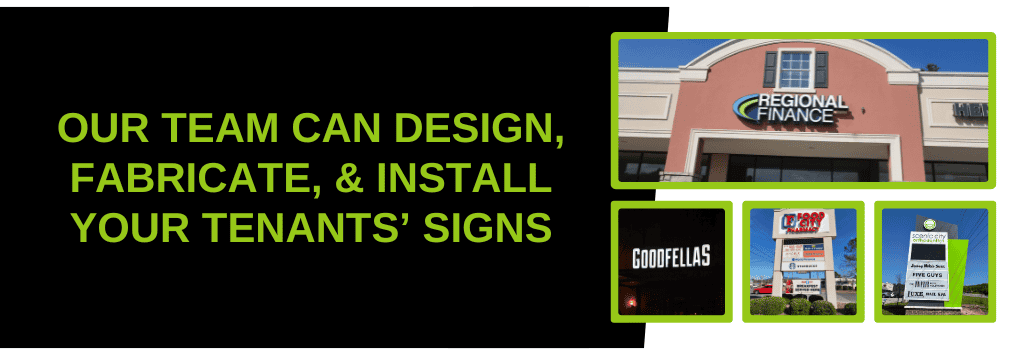Commercial Property Owners and Tenants work closely together, but at times each person may feel like they’re speaking different languages. Of course they have their own unique wants and needs out of the relationship; however, ultimately they can have a successful partnership that is beneficial to both parties. This is true broadly for their business relationship and it’s also true for their signage. As a sign company we work with both to ensure signs represent the property and the tenant’s business in the best way possible.
In this guide, we wanted to break down what is most important for landlords and tenants to know in regards to signage in the hopes of helping illuminate this issue for all parties.
What Property Owners Should Know
Property Owners have to keep two thoughts in mind: the needs of their tenants and also the long term needs of their property. Here are some tips we suggest for landlords looking to include consistent signage that looks good for your tenants and doesn’t impact your building’s facade.
- Require Your Tenants to Acquire Lit Signs on Raceways
To help your tenants’ businesses look good day or night, we recommend you institute a policy that they need lit signs on raceways. One example that’s popular for properties is for tenants to be required to acquire a set of channel letters. Channel letters allow for branding colors and logos to be used, while also helping with a consistent look. Channel letters are also lit, either internally or backlit, which allows for the sign to stand out at night. By using a raceway there is less damage to the walls, as the signs will be mounted to the raceway and not drilled into the wall itself.
- Institute Size Restrictions for Tenant Signs
Typically commercial properties restrict signs to 75%-85% of the frontage width. This allows for some space in between neighboring tenants signs, which helps them stand out more. Likewise a max size limit for the signs helps to give a cohesive look and feel, and thus no sign’s competing against their neighbors.
- Be Specific with Your Sign Rules
Leases are business agreements, so it’s of course important to be as specific as possible with your tenants rules and regulations. This is as true with signage as it is any other element of your contract with your tenants. First time tenants may not realize there are sign rules and restrictions, and by specifically stating them you’ll help save them time as well since they won’t inadvertently seek quotes for signage they cannot have on their building.
- Specify Who Needs to Remove the Sign
Though leases vary, typically tenants are required to remove their business signage when moving or shutting down their business. However this must be stated clearly in the lease if that’s the expectation.
What Tenants Should Know
When you sign an agreement with a property owner, undoubtedly you’re overwhelmed by all the details you need to keep in mind. One that’s often overlooked is the signage of your tenant space. Here we have some advice for business owners for the entire lifecycle of your business.
- Develop Your Business Plan with Signage in Mind
Signage is all too often an afterthought of a business, and this is just as true for tenants moving into commercial properties. By planning ahead though you can plan for the costs to purchase and install a sign, and working in tandem with your lease agreement you can also plan how best to showcase your branding on your sign. Most likely the landlord will have sign specifications for what your sign can and cannot look like, and that’s important to know at the start.
- Be Sure to Fully Review Your Lease
It’s understandable that there’s a lot to review when signing a lease agreement; however, be sure that when going over your agreement that you fully read any and all sign requirements. As a tenant, you’ll be responsible for much of your sign, so any sign you purchase will need to fit in with the guidelines provided to you from the property owner. You don’t want to waste your time or money trying to secure a sign that will not be allowed on your building.
- What Types of Signs are Typically Allowed for Tenant Spaces?
Tenants generally have 2 places where they may have a sign to represent their business: the facade of your building and a monument or pylon sign by the road. Monuments/Pylons will have panels that can be inserted with the name and logo of your business. Facades will often need a set of channel letters on a raceway, or multiple raceways depending on the verbiage & logos, which the tenant will need to acquire. Landlords will often require these types of signs for ease of install and to protect the integrity of the building long-term.
- Sign Guidelines for Commercial Properties
Sometimes tenants can see the rules and regulations incurred upon their tenant space as an unnecessary constraint, especially if they feel they have a really “novel” idea for a sign. However, sign constraints are often developed not just to help the overall property look the best it can be but also each individual tenant’s signs look the best too. For instance, by limiting signage to 75-80% of the frontage, landlords are keeping in mind municipal permits, which often already restrict signage size, and they’re making sure tenant’s signs do not bleed over into another tenant’s space. Likewise requirements such as a raceway actually help with your sign’s installation, as a sign company is more easily able to remove and install a sign on a raceway. Raceways are usually painted to match the color of the building as well, so they are not standing out in contrast to your sign.
- Who’s Responsible for Obtaining Sign Permits for My Tenant Signs?
Sign Permits in most municipalities are required for long-term signage, and it is the responsibility of the tenant to work with your sign company to secure such permits. Don’t fret though because at Ortwein Sign, we have years of combined experience pulling permits for signs in municipalities large and small. We can put our expertise to work for you and help with any headaches that can arise in the sign permitting process.


